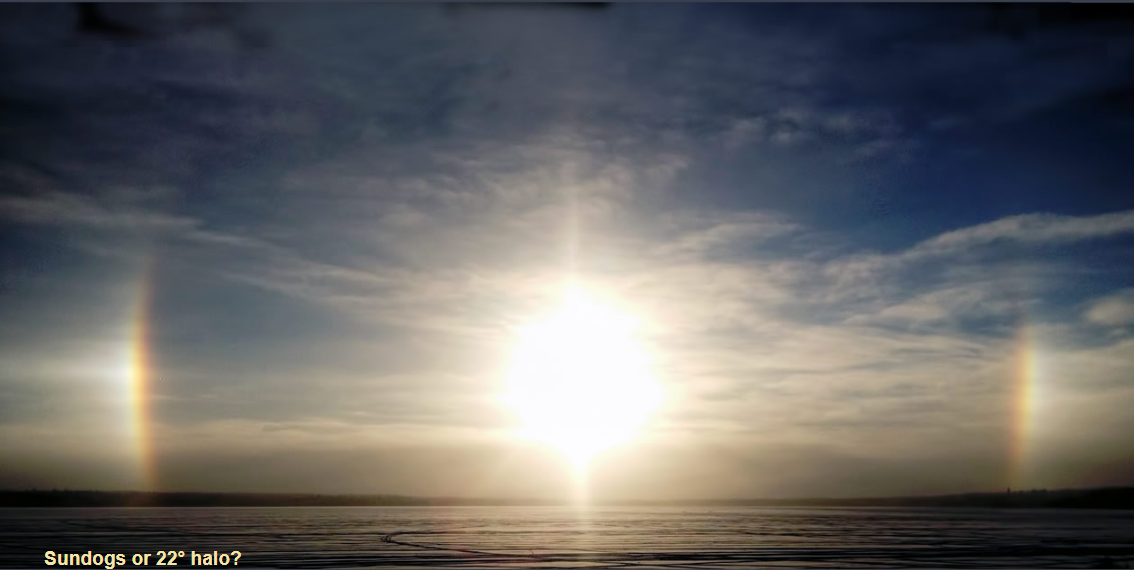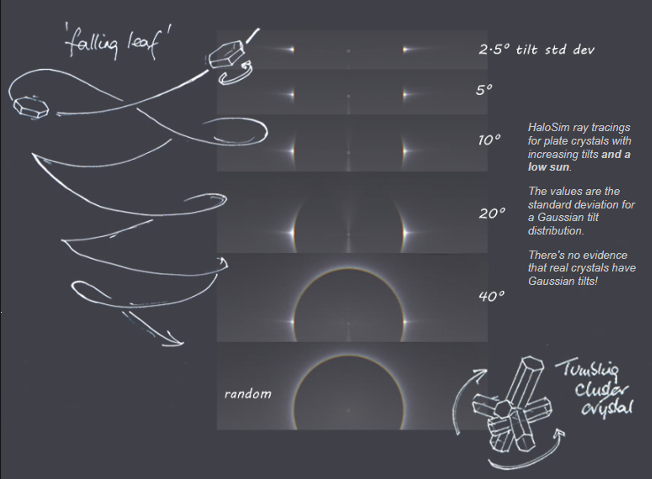Sundog or 22deg Halo - OPOD
Sundog or 22° Halo - A Phenomenon of Atmospheric Optics
Sundogs and 22° halos are fascinating atmospheric optical phenomena that captivate the attention of skywatchers worldwide. These beautiful displays are caused by the interaction of sunlight with ice crystals in the atmosphere. While sundogs and 22° halos share similar ray paths, they can be distinguished by the orientation of the ice crystals involved.
-
Sundogs and Extreme 22° Halos: Sundogs are created by almost horizontal plate crystals, while extreme 22° halos are formed by hexagonal crystals, likely in cluster formations, tumbling in all directions. The distinction between the two becomes blurred when observing intermediate cases where the height and completion of sundogs and 22° halos vary.
-
Crystal Orientation: The primary factor that differentiates sundogs from 22° halos is the orientation of the ice crystals. Sundogs are produced by plate crystals that wobble and tilt as the sun lowers in the sky. As the tilt increases, taller sundogs are formed, which can also be considered as segments of the 22° halo. On the other hand, the 22° halo can be generated by not only random orientations but also plates and columns with large tilts.
-
Position with Respect to the Sun: The position of sundogs and 22° halos in relation to the sun changes as its elevation in the sky alters. At lower sun angles, sundogs are closer to the sun and can coincide with segments of the 22° halo. However, as the sun rises higher, sundogs move further away from the sun and become distinct from the 22° halo.
-
The Influence of Crystal Tilt: As the sun's elevation increases, increasingly tilted plate crystals contribute to the formation of both sundogs and segments of the 22° halo. The varying tilt angles of these crystals result in the appearance of sundogs and the extension of the 22° halo.
-
Pendulum-like Motion: It is believed, though not proven, that large plate crystals descend in a fluttering motion, similar to autumn leaves, relative to the local air currents within the clouds. This downward motion causes the crystals to tilt, with the greatest tilts occurring at the ends of their pendulum-like swings. However, further research is needed to confirm this hypothesis.
Understanding the mechanisms behind sundogs and 22° halos allows us to appreciate the complexity and beauty of atmospheric optics. These optical phenomena serve as reminders of the intricate interplay between sunlight and ice crystals suspended in the atmosphere.
In conclusion, sundogs and 22° halos are mesmerizing atmospheric displays resulting from the interaction of sunlight with ice crystals. While sundogs are formed by almost horizontal plate crystals, extreme 22° halos arise from hexagonal crystals tumbling in various directions. The orientation of these crystals determines whether they manifest as sundogs or segments of the 22° halo. As the sun's position changes throughout the day, so does the appearance and location of these phenomena. The scientific exploration of sundogs and 22° halos continues to deepen our understanding of atmospheric optics and the wonders of our natural world.

Sundogs or 22° halo?
Imaged by Norma Wallace at Christopher Lake, Saskatchewan, Canada. ©Norma Wallace, shown with permission
Extreme sundogs are made by almost horizontal plate crystals. Extreme 22° halos are from hexagonal crystals of some sort – probably clusters – tumbling in all directions.
Between the extremes are apparently ever taller ‘sundogs’ and 22° halos of various completion.
Both halos have the same ray paths, only crystal orientation distinguishes them and those demarcations are blurred.
At low sun, plate crystals of increasing wobble give taller sundogs which can also be considered to be ever increasing segments of the 22° halo. The latter does not need random orientations – plates and columns with large tilts also generate it.
At higher sun the sundog moves further from the sun and is no longer concident with the 22 degree halo. Increasingly tilted plate crystals then produce a sundog and a segement of the 22° halo!

It's thought - but not proven - that large plate crystals flutter downwards, relative to local cloud air currents, like autumn leaves. Greatest tilts would be at the ends of the pendulum like swings.
But we do not know for certain.
Note: this article has been automatically converted from the old site and may not appear as intended. You can find the original article here.
Reference Atmospheric Optics
If you use any of the definitions, information, or data presented on Atmospheric Optics, please copy the link or reference below to properly credit us as the reference source. Thank you!
-
<a href="https://atoptics.co.uk/blog/sundog-or-22deg-halo-opod/">Sundog or 22deg Halo - OPOD</a>
-
"Sundog or 22deg Halo - OPOD". Atmospheric Optics. Accessed on November 26, 2024. https://atoptics.co.uk/blog/sundog-or-22deg-halo-opod/.
-
"Sundog or 22deg Halo - OPOD". Atmospheric Optics, https://atoptics.co.uk/blog/sundog-or-22deg-halo-opod/. Accessed 26 November, 2024
-
Sundog or 22deg Halo - OPOD. Atmospheric Optics. Retrieved from https://atoptics.co.uk/blog/sundog-or-22deg-halo-opod/.